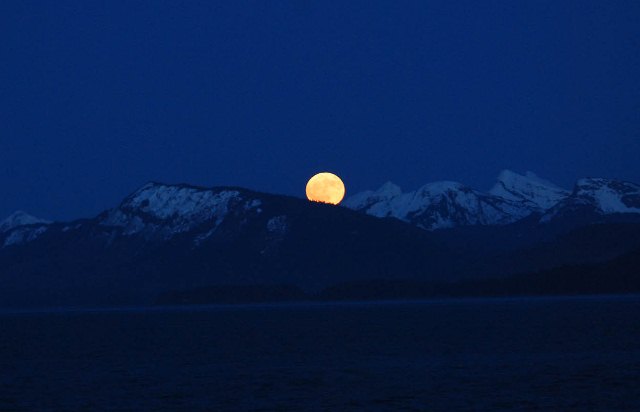
Did you see that awesomely big supermoon this past Sunday, June 23rd? This closest full moon of the year was an
impressive sight to behold wherever you happened to view it from. The event added another layer of scenic beauty
to this place where ocean, glacier, and mountain meet. Residents and visitors in Glacier Bay and other coastal areas
think about the moon a bit differently than most people may be used to. We are still experiencing the effects of that
supermoon. In fact, the moon's influence is evident in the movement, color, and contents of the waters pulsing in and
out of the bay. Celestial bodies like the moon and the sun draw the earth's oceans towards themselves creating tides.
The day after the supermoon made its appearance, Monday, June 24th, we experienced the largest tidal change of
the summer! At 02:07 AM the tide was 18.1 ft (552 cm) high then dropped to -4.8 ft (-146 cm) low at 08:40 AM. That
is a difference of 22.9 vertical feet ( cm) over the course of only about 6 hours! At 03:13 PM the tide had increased
20.2 ft ( cm) back up to a high of 15.4 ft (469 cm). Glacier Bay has the second largest range of tidal variation in the
world to the Bay of Fundy. The tides certainly come into play when planning a boat trip in the park. They are also an
important and often unrecognized factor driving the productivity of the park's marine and terrestrial ecosystems.
Here in Glacier Bay we see a prolonged bloom of phytoplankton throughout the summer and into the fall. You can
see the profusion of life making itself known by turning the water a brilliant turquoise color. Lots of temperate fjords
have a few phytoplankton blooms over the course of the summer. Glacier Bay is unique in its extended bloom. Fresh-
water input is initiated by snow melt in May and continues with glacial runoff throughout the summer and into the fall.
Glaciers often glide down mountain slopes over a layer of water which pours out into the bay. Tidewater glaciers also
contribute chunks of themselves as pieces of ice calve (or fall off) the toe of the glaciers and into the water. A layer
of fresh water sits atop the heavier salt water from the ocean. Sunlight penetrates that layer of fresh water near the
surface creating a photic zone in which phytoplankton can grow. The big tidal fluctuations perturb the bottom of that
photic zone enough to mix nutrients from the depths up. This constant influx of fresh water combined with tidal mixing
creates the perfect conditions for continual phytoplankton blooms. These microscopic plants are the base of the
marine food chain. They attract zooplankton and small fish which are fed upon by the larger animals like humpback
whales that many of us come to Glacier Bay to see. As the saying around here goes, "when the tide is out, the table
is set." All animals (including humans) that are able to will come to the intertidal zone to feed. They then enrich the
terrestrial system with marine nutrients. Energy and nutrients are transferred from the marine environment throughout
the entire area, even all the way up into the high Fairweather mountains that we watched the supermoon set over.
Have a great weekend.
